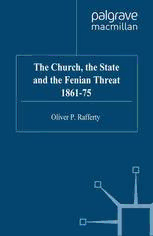
The Church, the State and the Fenian Threat 1861–75 PDF
Preview The Church, the State and the Fenian Threat 1861–75
THE CHURCH, THE STATE AND THE FENIAN THREAT, 1861-75 Also by Oliver P. Rafferty RECONCILIATION: Essays in Honour of Michael Hurley CATHOLICISM IN ULSTER, 1603-1983: an Interpretative History The Church, the State and the Fenian Threat 1861-75 Oliver P. Rafferty Senior Tutor Campion Hall Oxford 19 © Oliver P. Rafferty 1999 Softcover reprint of the hardcover 1st edition 1999978-0-333-74962-3 All rights reserved. No reproduction, copy or transmission of this publication may be made without written permission. No paragraph of this publication may be reproduced, copied or transmitted save with written permission or in accordance with the provisions of the Copyright, Designs and Patents Act 1988, or under the terms of any licence permitting limited copying issued by the Copyright Licensing Agency, 90 Tottenham Court Road, London W1P OlP. Any person who does any unauthorised act in relation to this publication may be liable to criminal prosecution and civil claims for damages. The author has asserted his right to be identified as the author of this work in accordance with the Copyright, Designs and Patents Act 1988. Published by PALGRAVE Houndmills, Basingstoke, Hampshire RG21 6XS and 175 Fifth Avenue, New York, N. Y. 10010 Companies and representatives throughout the world PAlGRAVE is the new global academic imprint of St. Martin's Press lLC Scholarly and Reference Division and Palgrave Publishers ltd (formerly Macmillan Press Ltd). ISBN 978-1-349-41184-9 ISBN 978-0-230-28658-0 (eBook) DOI 10.1057/9780230286580 This book is printed on paper suitable for recycling and made from fully managed and sustained forest sources. A catalogue record for this book is available from the British Library. Transferred to digital printing 2001 For my brother Francis with affection Contents Preface ix Acknowledgements xvi List ofA bbreviations xviii 1 Fenianism Reconsidered 1 The Problems Posed by Fenianism 1 The Church and the Fenians 5 The Fenians in America 7 The Politics of Fenianism 8 Interpretations of Fenianism 10 Conclusion 14 2 Church and State Reactions to Fenianism, 1861-65 17 The Political Background 17 Ecclesiastical Factors 19 Agricultural Crisis and Politics 21 Fenian Organization and Police Surveillance 23 The MacManus Funeral: a Governmental and 25 Ecclesiastical Problem The Foundation of The Irish People and the 36 Growth of Fenianism The Trials of Fenianism 41 3 Fenianism in North America 52 The Background 52 The Church and Fenianism in North America 53 The Fenians and North American Politics 73 Conclusion 80 4 Fenianism Subdued and Authority Upheld? 83 The Fenians Prepare 83 The Rising 89 Ecclesiastical Reaction 94 Fenianism on Trial and the Continued Threat 96 The Manchester and Clerkenwell Incidents 99 A Scottish Interlude 105 The Beginnings of Reform 108 Elections and Continued Threat 111 vii viii Contents Conclusion 116 5 The Politics of Condemnation 120 Amnesty, Reform and Coercion 120 The Papal Condemnation 126 The Road to Politics 133 University Education and the Synod of Maynooth 139 6 Conclusion: the Church, the State and the 143 Endurance of Fenianism The Fenians and the Church 143 The Fenians and the State 151 The Legacy of Fenianism 155 Notes 160 Bibliography 197 Index 221 Preface By September 1865 the British government in Ireland had determined to move decisively against the Fenian organization. Accordingly, it suppressed the most public manifestation of the movement: the Fenian newspaper, The Irish People. Why it had waited so long before attempting to act definitively against the revolutionaries, whom it had had under close surveillance for somc time, must remain a matter of speculation. It is clear, howcver, that its miscalculation over the danger posed by the Irish Revolutionary Brotherhood, as the Irish Republican Brotherhood was also known, was a product of a combin ation of incompetence and disdain. The Catholic Church in Ireland, by contrast, was alive to the dangers of the Fenian movement since the first appearance, in 1861, of what became its front organization: the National Brotherhood of St Patrick. Although the movement had been started in 1858, it was not until 1861 that it made its first large-scale impact on Irish public opinion, owing to its involvement with the reburial in Ireland in November that year of the 1848 hero Terence Bellew McManus. Over the next 15 years, until thc first Synod of Maynooth in 1875, when the 1870 papal condemnation of Fenianism was again commended to the Irish faithful, the Church waged a relentless campaign against the would-be revolutionaries. The Church regarded Fenianism as, essen tially, a spiritual danger. It resisted revolution in Ireland since it believcd such activity to be immoral and it was, moreover, opposed to any association whose members were involved in taking secret oaths, such oaths being contrary to Church teaching. The struggle between the Church and the Fenians in Ireland was part of a wider conflict about the relationship between Church and society, which had been going on since the beginning of the nine teenth century, but which was given fresh impetus by the attempts of Italian revolutionaries to deprive thc Pope of the Papal States. Revolution in all its aspects, whether in Italy or in Ireland, was condemned since it threatened the Church's direct political aims. The question of social control was an issue for the Universal Church but that is not to say that there was a univocal policy on the part of Church leaders in the face of widespread disorder. Despite proclamations of unbending moral principle, the Church adapted its IX
